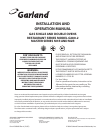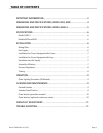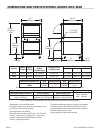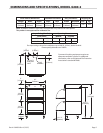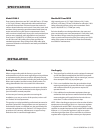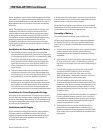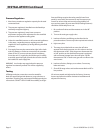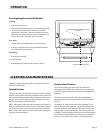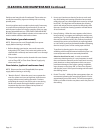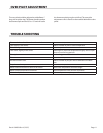
Part # 1382650 Rev 4 (12/07)Page 10
CLEANING AND MAINTENANCE Continued
Stainless steel may discolor if overheated. These stains can
usually be removed by vigorous rubbing with a scouring
powder paste.
Use only stainless steel, wooded or plastic tools if necessary
to scrape o heavy deposits of grease and oil. Do not use
ordinary steel scrapers of knives as particles of the iron may
become imbedded and rust. STEEL WOOL SHOULD NEVER
BE USED. Either a typical bleach solution or hot water can be
used to sanitize stainless steel with out harm.
Oven Interior (porcelain enamel)
NOTE: Disconnect line cord (if applicable) from power
supply before cleaning or servicing.
1. Before cleaning oven interior, remove all oven racks
and guides (if “RC” base). Oven racks and guides can be
cleaned with a mild soap and warm water or run through
dish washer.
2. The porcelain interior can be cleaned with oven cleaners
such as “Easy-O”, or “Dow Oven Cleaner”. Apply only
when oven is cold.
Oven Interior, (optional continuous clean)
NOTE: Disconnect line cord (if applicable) from power
supply before cleaning or servicing.
1. “Break-In Period” – When the oven is new, operate the
oven for at least two hours at high heat, with the oven
empty, before normal cooking operation. Continue
preheating the oven for two hours prior to use during
the rst two weeks. During this break-in period, it is
important that the oven surfaces be kept clean of
excessive soiling due to spillage.
2. How to put “continuous cleaning” action to work: each
day, after baking and roasting operations have ceased
empty the oven, turn the temperature control up to high
heat (500°). This high heat will accelerate the cleaning
action and reduce the time required to eectively clean
the oven. Usually the cleaning operation will take about
45 to 60 minutes.
3. Heavy Staining – When the oven appears soiled, due to
heavy staining, we suggest pre-heating the empty oven
each day for 1 or 2 hours (depending on the condition of
the oven) for eective results. Also, ordinary household
ammonia has proven to be eective in removing baked-
on “soil” build-up and has the benecial eect of keeping
the microscopic “pores” of the coating open and free
To perform its cleaning action. An occasional light
swabbing with household ammonia while the oven is at
room temperature will prove extremely benecial.
Abrasives should not be used – in order to maintain
continuous cleaning action, it is very important to avoid
the use of abrasive materials such as steel wool scouring
pads, abrasives or sharp implements which can cause
permanent damage to the surface coating. In addition
oven cleaners such as “easy-O” or “Dow Oven Cleaner”
will clog the “pores” of the special coating and will retard
the cleaning action.
4. Period “Tune-Up” – Although the oven appears clean, we
recommend operating the oven at high heat for 2 hours
approximately once each month. This will insure against
build-up of solids in hard to see places and in the pores of
the coating.



